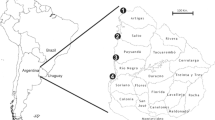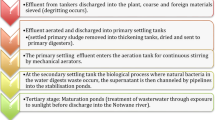Abstract
Studies have confirmed silent circulation of enteroviruses in the environment even in the absence of associated clinical conditions in the community. In this light, 26 samples of sewage and sewage-contaminated water serving selected high-risk communities in Lagos Nigeria were examined between June and September 2010. To concentrate virus particles in the sample, 480 μL of each sample was centrifuged at 3,000 rpm for 1 h at 4 °C. Subsequently, pellets were pooled, chloroform treated and further centrifuged at 1,500 rpm for 20 min at 4 °C. The water phase (concentrate) was then collected and stored at −20 °C. The concentrates were subsequently inoculated into RD and L20B cell lines. Recovered isolates were identified by real-time RT-PCR (rRT-PCR), serotyping, VP1 amplification, sequencing and phylogenetic analysis. Overall, 9 (34.6 %) of the samples showed characteristic enterovirus cytopathic effect in RD cell line and were subsequently confirmed by pan-enterovirus rRT-PCR. The isolates were further identified by serotyping to include three E7, one E11 and one E13 isolates whilst four isolates were untypable. Further characterisation by VP1 sequencing confirmed the results of serotyping and rRT-PCR for all but isolate E13. Also, the four previously untypable isolates were identified to include two E19, one E20 and one E7 by VP1 sequencing. Results of the study confirmed circulation of Sub-Saharan Africa-specific enterovirus clades in the region, provide information on their molecular epidemiology and emphasise the need to combine methods of identification to enhance enterovirus surveillance.




Similar content being viewed by others
References
Abzug, M. J. (2004). Presentation, diagnosis, and management of enterovirus infections in neonates. Paediatric Drugs, 6(1), 1–10.
Andersen, K. G., Shylakhter, I., Tabrizi, S., Grossman, S. R., Happi, C. T., & Sabeti, P. C. (2012). Genome-wide scans provide evidence for positive selection of genes implicated in Lassa fever. Philosophical Transactions of the Royal Society of London, Series B, Biological Sciences, 367(1590), 868–877.
Archimbaud, C., Bailly, J. L., Chambon, M., Tournilhac, O., Travade, P., & Peigue-Lafeuille, H. (2003). Molecular evidence of persistent echovirus 13 meningoencephalitis in a patient with relapsed lymphoma after an outbreak of meningitis in 2000. Journal of Clinical Microbiology, 41(10), 4605–4610.
Baba, M. M., Oderinde, B. S., Patrick, P. Z., & Jarmai, M. M. (2012). Sabin and wild polioviruses from apparently healthy primary school children in northeastern Nigeria. Journal of Medical Virology, 84(2), 358–364.
Bessaud, M., Pillet, S., Ibrahim, W., Joffret, M. L., Pozzetto, B., Delpeyroux, F., et al. (2012). Molecular characterization of human enteroviruses in the Central African Republic: uncovering wide diversity and identification of a new human enterovirus A71 genogroup. Journal of Clinical Microbiology, 50(5), 1650–1658.
Blomqvist, S., Paananen, A., Savolainen-Kopra, C., Hovi, T., & Roivainen, M. (2008). Eight years’ experience of molecular identification of human enteroviruses. Journal of Clinical Microbioliology., 46(7), 2410–2413.
Burns, C. C., Shaw, J., Jorba, J., Bukbuk, D., Adu, F., Gumede, N., et al. (2013). Multiple independent emergences of type 2 vaccine-derived polioviruses during a large outbreak in Northern Nigeria. Journal of Virology, 87(9), 4907–4922.
Caro, V., Guillot, S., Delpeyroux, F., & Crainic, R. (2001). Molecular strategy for ‘serotyping’ of human enteroviruses. Journal of General Virology, 82(1), 79–91.
Casas, I., Palacios, G. F., Trallero, G., Cisterna, D., Freire, M. C., & Tenorio, A. (2001). Molecular characterization of human enteroviruses in clinical samples: comparison between VP2, VP1, and RNA polymerase regions using RT nested PCR assays and direct sequencing of products. Journal of Medical Virology, 65(1), 138–148.
Castro, R. (2000). Echovirus 7 infection and necrotizing enterocolitis-like symptoms in a premature infant. Journal of Perinatology, 20(8), 558–561.
Center for Disease Control and Prevention. (2006). Enterovirus surveillance—United States 1970–2005. Morbidity and Mortality Weekly report, Surveillance Summaries, 55(5), 8–48.
El Bassioni, L., Barakat, I., Nasr, E., de Gourville, E. M., Hovi, T., Blomqvist, S., et al. (2003). Prolonged detection of indigenous wild poliovirusesin sewage from communities in Egypt. American Journal of Epidemiology, 158(8), 807–815.
Hovi, T., Blomqvist, S., Nasr, E., Burns, C., Sarjakoski, T., Ahmed, N., et al. (2005). Environmental surveillance of wild poliovirus circulation in Egypt–balancing between detection sensitivity and workload. Journal of Virological Methods, 126(1–2), 127–134.
Iwai, M., Horimoto, E., Obara, M., Obuchi, M., Kurata, T., Kawagoshi, K., et al. (2011). Endemic transmission of echovirus 30 in Toyama, Japan in 2010 is verified by environmental surveillance. Japanese Journal of Infectious Disease., 64(2), 165–167.
Kargar, M., Sadeghipour, S., & Nategh, R. (2009). Environmental surveillance of Non-polio Enteroviruses in Iran. Virology Journal., 6, 149–153.
Kilpatrick, D. R., Nottay, B., Yang, C. F., Yang, S. J., Da Silva, E., Peñaranda, S., et al. (1998). Serotype-specific identification of polioviruses by PCR using primers containing mixed-base or deoxyinosine residues at positions of codon degeneracy. Journal of Clinical Microbiology, 36(2), 352–357.
Kilpatrick, D. R., Yang, C. F., Ching, K., Vincent, A., Iber, J., Campagnoli, R., et al. (2009). Rapid group-, serotype-, and vaccine strain-specific identification of poliovirus isolates by real-time reverse transcription-PCR using degenerate primers and probes containing deoxyinosine residues. Journal of Clinical Microbiology, 47(6), 1939–1941.
Kimura, M. (1980). A simple method for estimating evolutionary rate of base substitutions through comparative studies of nucleotide sequences. Journal of Molecular Evolution, 16(2), 111–120.
Kobayashi, K., Haruta, T., Kubota, M., Akiyoshi, K., Suga, T., & Ito, M. (2005). Clinical spectrum in hospitalized children with echovirus type 13 infection. Pediatric International, 47(2), 185–189.
Kroneman, A., Vennema, H., Deforche, K., Van der Avoort, H., Penarandac, S., Oberste, M. S., et al. (2011). An automated genotyping tool for enteroviruses and noroviruses. Journal of Clinical Virology, 51(2), 121–125.
Lin, T. Y., Kao, H. T., Hsieh, S. H., Huang, Y. C., Chiu, C. H., Chou, Y. H., et al. (2003). Neonatal enterovirus infections: emphasis on risk factors of severe and fatal infections. Pediatric Infectious Disease Journal, 22(10), 889–894.
Lum, L. C., Chua, K. B., McMinn, P. C., Goh, A. Y., Muridan, R., Sarji, S. A., et al. (2002). Echovirus 7 associated encephalomyelitis. Journal of Clinical Virology, 23(3), 153–160.
Manor, Y., Blomqvist, S., Sofer, D., Alfandari, J., Halmut, T., Abramovitz, B., et al. (2007). Advanced environmental surveillance and molecular analyses indicate separate importations rather than endemic circulation of wild type 1 poliovirus in Gaza district in 2002. Applied and Environmental Microbiology, 73(18), 5954–5958.
Mateu, M. G. (1995). Antibody recognition of picornaviruses and escape from neutralization: a structural view. Virus Research, 38(1), 1–24.
Minor, P. D. (1990). Antigenic structure of picornaviruses. Current Topics in Microbiology and Immunology, 161, 121–154.
Mullins, J. A., Khetsuriani, N., Nix, W. A., Oberste, M. S., LaMonte, A., Kilpatrick, D. R., et al. (2004). Emergence of echovirus type 13 as a prominent enterovirus. Clinical Infectious Disease., 38(1), 70–77.
Nathanson, N., & Kew, O. M. (2010). From emergence to eradication: The epidemiology of poliomyelitis deconstructed. American Journal of Epidemiology, 172(11), 1213–1229.
Norder, H., Bjerregaard, L., & Magnius, L. O. (2001). Homotypic echoviruses share aminoterminal VP1 sequence homology applicable for typing. Journal of Medical Virology, 63(1), 35–44.
Oberste, M. S., Maher, K., Flemister, M. R., Marchetti, G., Kilpatrick, D. R., & Pallansch, M. A. (2000). Comparison of classic and molecular approaches for the identification of untypeable enteroviruses. Journal of Clinical Microbiology, 38(3), 1170–1174.
Oberste, M. S., Maher, K., Kilpatrick, D. R., Flemister, M. R., Brown, B. A., & Pallansch, M. A. (1999a). Typing of human enteroviruses by partial sequencing of VP1. Journal of Clinical Microbiology, 37(5), 1288–1293.
Oberste, M. S., Maher, K., Kilpatrick, D. R., & Pallansch, M. A. (1999b). Molecular evolution of the human enteroviruses: Correlation of serotype with VP1 sequence and application to picornavirus classification. Journal of Virology, 73(3), 1941–1948.
Oberste, M. S., Nix, W. A., Maher, K., & Pallansch, M. A. (2003). Improved molecular identification of enteroviruses by RT–PCR and amplicon sequencing. Journal of Clinical Virology, 26(3), 375–377.
Oberste, M. S., Schnurr, D., Maher, K., al-Busaidy, S., & Pallansch, M. A. (2001). Molecular identification of new picornaviruses and characterization of a proposed enterovirus 73 serotype. Journal of General Virology, 82(2), 409–416.
Oyero, O. G., & Adu, F. D. (2010). Non-polio enteroviruses serotypes circulating in Nigeria. African Journal of Medical Sciences., 39(S), 201–208.
Ranta, J., Hovi, T., & Arjas, E. (2001). Poliovirus surveillance by examining sewage water specimens: Studies on detection probability using simulation models. Risk Analysis, 21(6), 1087–1096.
Rao, D. C., Ananda Babu, M., Raghavendra, A., Dhananjaya, D., Kumar, S., & Maiya, P. P. (2013). Non-polio enteroviruses and their association with acute diarrhea in children in India. Infection Genetics and Evolution., 17, 153–161.
Sadeuh-Mba, S. A., Bessaud, M., Massenet, D., Joffret, M. L., Endegue, M. C., Njouom, R., et al. (2013). High frequency and diversity of species C enteroviruses in Cameroon and neighboring countries. Journal of Clinical Microbiology, 51(3), 759–770.
Sedmak, G., Bina, D., & MacDonald, J. (2003). Assessment of an enterovirus sewage surveillance system by comparison of clinical isolates with sewage isolates from Milwaukee, Wisconsin, collected August 1994 to December 2002. Applied and Environmental Microbiology, 69(12), 7181–7187.
Tamura, K., Peterson, D., Peterson, N., Stecher, G., Nei, M., & Kumar, S. (2011). MEGA5: Molecular evolutionary genetics analysis using maximum likelihood, evolutionary distance, and maximum parsimony methods. Molecular Biology and Evolution, 28(10), 2731–2739.
Thoelen, I., Lemey, P., Van der Donck, I., Beuselink, K., Lindberg, A. M., & Van Ranst, M. (2003). Molecular typing and epidemiology of enteroviruses identified from an outbreak of aseptic meningitis in Belgium during the summer of 2000. Journal of Medical Virology, 70(3), 420–429.
Wassilak, S., Pate, M. A., Wannemuehler, K., Jenks, J., Burns, C., Chenoweth, P., et al. (2011). Outbreak of type 2 vaccine-derived poliovirus in Nigeria: Emergence and widespread circulation in an underimmunized population. Journal of Infectious Disease., 203(7), 898–909.
Wilson, C. W., Stevenson, D. K., & Arvin, A. M. (1989). A concurrent epidemic of respiratory syncytial virus and echovirus 7 infections in an intensive care nursery. Pediatric Infectious Disease Journal., 8(1), 24–29.
World Health Organisation. (2003). Guidelines for environmental surveillance of poliovirus circulation. Geneva: EEA Press.
World Health Organisation. (2004). Polio laboratory Manual (4th ed.). Geneva: IVP Press.
Wreghitt, T. G., Sutehall, G. M., King, A., & Gandy, G. M. (1989). Fatal echovirus 7 infection during an outbreak in a special care baby unit. Journal of Infection, 19(3), 229–236.
Acknowledgments
We thank Dr. Adewumi MO for thoughtful critique of our manuscript, the entire staff of the WHO National Polio Laboratory in Ibadan Nigeria for their valuable technical assistance and RIVM, The Netherlands, for the enterovirus antisera panel. FTOC is a PhD student studying the evolutionary dynamics of enteric viruses in Nigeria. This study is a part of his PhD work.
Conflict of interest
The authors declare no conflict of interests.
Author information
Authors and Affiliations
Corresponding author
Rights and permissions
About this article
Cite this article
Adeniji, J.A., Faleye, T.O.C. Isolation and Identification of Enteroviruses from Sewage and Sewage-Contaminated Water in Lagos, Nigeria. Food Environ Virol 6, 75–86 (2014). https://doi.org/10.1007/s12560-014-9137-5
Received:
Accepted:
Published:
Issue Date:
DOI: https://doi.org/10.1007/s12560-014-9137-5




